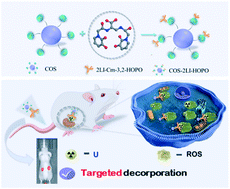Decorporation of uranyl in kidneys using an engineered nanocomposite†
Abstract
Internal exposure to uranium, a well-recognized nuclear material poses a health risk to the public, especially in contamination zones. However, the fast excretion and non-target distribution of most molecular decorporation ligands greatly reduce the decorporation efficacy, and frequent administrations are often required. To make matters worse, the clinical application of many molecular decorporation agents is restrained due to their high toxicity. Herein, we synthesized a carboxyl functionalized tetradentate hydroxypyridinone (HOPO) ligand and attached it onto chitosan oligosaccharide (COS) nanoparticles via amidation to yield a COS-2LI-HOPO composite. The biodistribution and pharmacokinetic studies verify the long-term accumulation of COS-2LI-HOPO in the kidneys, which is beneficial to the removal of uranium. Besides, the cytotoxicity of the material is much lower than the HOPO ligands. In addition, the uranium decorporation efficacy is up to 54.8% and 35.2% for the kidneys with prophylactic and delayed administration, respectively. Moreover, the composite is recognized to be able to reduce the cellular ROS amount to the same level as the blank control group due to the synergistic ROS scavenging effect of COS and HOPO moieties. Our current results reveal the fabrication of a nanocomposite by the modification of a chelating agent onto COS is effective in reducing toxicity, regulating ROS, and achieving kidney oriented decorporation of uranyl.

- This article is part of the themed collection: Environmental Science: Nano Recent HOT Articles


 Please wait while we load your content...
Please wait while we load your content...